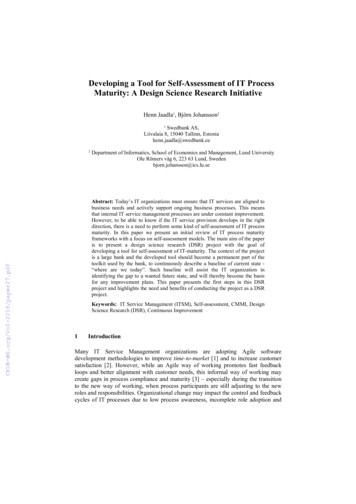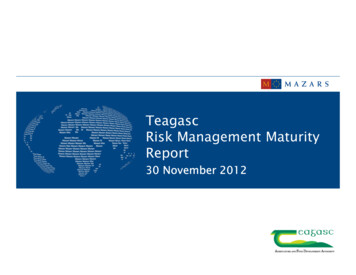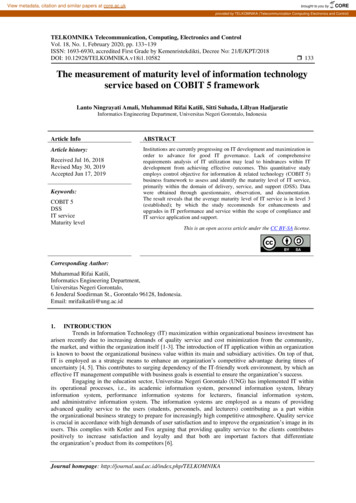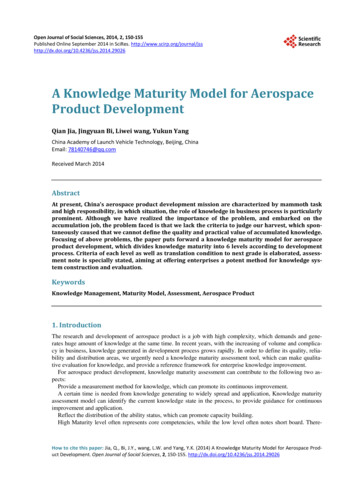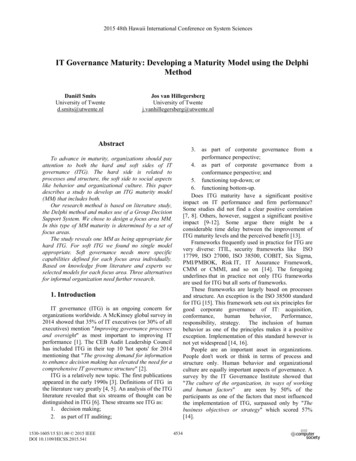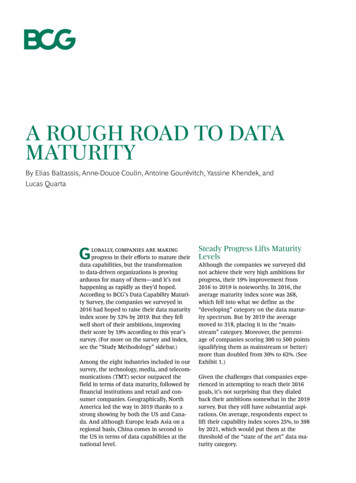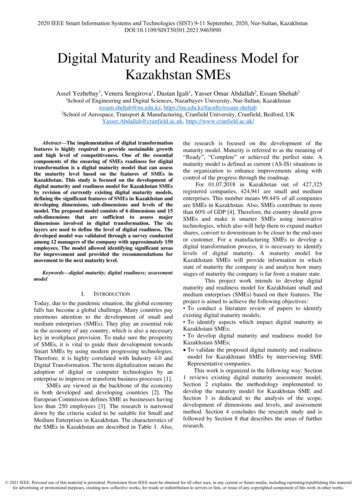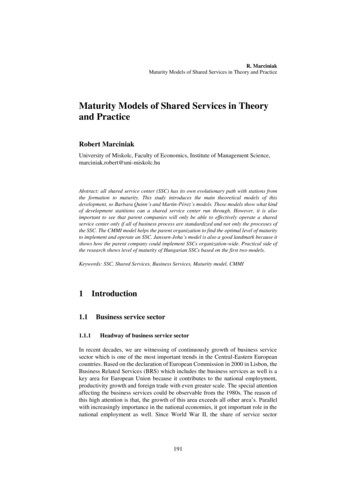
Transcription
R. MarciniakMaturity Models of Shared Services in Theory and PracticeMaturity Models of Shared Services in Theoryand PracticeRobert MarciniakUniversity of Miskolc, Faculty of Economics, Institute of Management Science,marciniak.robert@uni-miskolc.huAbstract: all shared service center (SSC) has its own evolutionary path with stations fromthe formation to maturity. This study introduces the main theoretical models of thisdevelopment, so Barbara Quinn’s and Martin-Pérez’s models. These models show what kindof development statitions can a shared service center run through. However, it is alsoimportant to see that parent companies will only be able to effectively operate a sharedservice center only if all of business process are standardized and not only the processes ofthe SSC. The CMMI model helps the parent organization to find the optimal level of maturityto implement and operate an SSC. Janssen-Joha’s model is also a good landmark because itshows how the parent company could implement SSCs organization-wide. Practical side ofthe research shows level of maturity of Hungarian SSCs based on the first two models.Keywords: SSC, Shared Services, Business Services, Maturity model, CMMI11.11.1.1IntroductionBusiness service sectorHeadway of business service sectorIn recent decades, we are witnessing of continuously growth of business servicesector which is one of the most important trends in the Central-Eastern Europeancountries. Based on the declaration of European Commission in 2000 in Lisbon, theBusiness Related Services (BRS) which includes the business services as well is akey area for European Union because it contributes to the national employment,productivity growth and foreign trade with even greater scale. The special attentionaffecting the business services could be observable from the 1980s. The reason ofthis high attention is that, the growth of this area exceeds all other area’s. Parallelwith increasingly importance in the national economies, it got important role in thenational employment as well. Since World War II, the share of service sector191
Management, Enterprise and Benchmarking in the 21 st CenturyBudapest, 2016workers has increased two and a half times. The dynamic of this growth was thehighest in the period followed by the change of regime in 1990s. [1]At the beginning of the 2000s, the total service sector gave more than 66% of theHungarian GDP and within the business services was 17%. The weight of theservices in the employment has been increased to 61% by 2003. [2]Nowadays the business services are the fastest growing sector of the economy inthe most developed countries. Hungary is still lagging with its about 8% of allemployees working in the business services sector, which is half to two-thirds ofthe value comparing with the developed market economies. [3]The business services are usually implemented in service centers that can operateindependent as a market service provider or as an organizational unit within theparent company. This research deals with the shared service centers owned by theparent company.1.1.2Shared service sectorWithin business services, the shared service model has particularly importance inHungary. Over the past decade, the large international companies’ service centerswere increased from zero to about one hundred in Hungary. Approximately fiftythousand people work in this sector in Hungary. Therefore the sector has nationaleconomic significance as well.The shared service center model appeared in the 1980s and since then it is in thefocus of private and public sector as well. Today, 80% of the world's largest 2,000companies use the shared service center model to support their activities. [4]The shared services take place in specific service centers called shared servicecenters. The benefits (mostly the savings) available through this service center aredifferently from business to business. The biggest savings can be detected for thoseservices in those companies that have high transaction volumes, because it can makethe major impact on the economies of scale available. [5]The main purpose of this model is to improve service quality and reduce costs, butthe benefits are now significantly expanded and includes e.g. standardization ofservices and processes, reducing administrative costs; or grouping similar tasks anddismantling of redundant tasks; supporting corporate strategy.The shared service centers provide a range of services primarily regional andsometimes global level, such as finance, accounting, procurement, logistics, IT andHR.192
R. MarciniakMaturity Models of Shared Services in Theory and Practice2Aim and method of researchThe research seeks to answer that during what kind of changes the service centersgo through their operation and to identify how major evolutionary-developmentalmodels exist in the literature. The empirical research gives an overview of thematurity level situation with the Hungarian shared service centers, using the twomost well-known evolutionary model.The research is based on the database of a questionnaire research. The questionnairewas online, standardized, self-administered and available optional in English orHungarian. The expected response rate was as large as possible, but at least a 50%.According to the database formerly compiled all shared service centers in Hungarywere targeted. 80 service centers of 73 companies were involved in the research and50 centers of 47 companies completed the questionnaire, so the response rate was62.5%. At determination of research population, all shared service centers wereinvolved, which were in the literature or a database of professional organizationsincluded it as an SSC and fulfilled the following criteria:-33.1during the research it had a site in Hungary;independently of other corporate activities it had a separate service center;and the services of this center were shared at least for the other departmentsof the parent company.Evolutionary models for shared service centersQuinn’s modelThe most important model was created by Barbara Quinn. Quinn developed a modelto categorize the different states of maturity in shared service model. [6] Quinndistinguished four archetypes: the first is the basic model that is followed by themarket model and the developed market model and finally the independent model.The model describes those evolutionary steps that a shared service center could gothrough. In this model, the more market-based the operation of service center is, themore advanced the shared service center in maturity.Quinn’s model shows four evolutional models as archetypes ranging from thesimplest one where only the transaction process functions are centralized till theindependent business model, which is operating as an independent business unitoutside the organization.In Quinn’s model the first archetype is the basic model in which the service centeris the level of initial consolidation where happens clarifying and merging of some193
Management, Enterprise and Benchmarking in the 21 st CenturyBudapest, 2016transactional background activities. The operational focus of the service center isprimary on achieving economies of scale there. The target is the biggest possiblecost savings and standardizing the service processes. The organization providesservices to the parent company. The relationship between the service center andrecipient side is market-based since there is charging of the total cost of the services.The second archetype, the market model could be interpreted as a kind of movingforward from the basic model. Those service centers which are already at this levelhave broader and more professional portfolio of services. The goal is also the costoptimization of the background activities and development of service quality. Inorder to reach it, the service centers separates their control and service providingactivities.1. Basic model2. Market model3. Advanced marketmodel4. Independent businessmodelConsolidation oftransactional/ administrativeworkIncludes professional andadvisory servicesClient choice of supplierSeparate business entityFocus on economies of scaleSeparation of governanceand service functionsMarket based pricingProfit is retainedServices charged out torecover fully loaded costsServices charged out torecover fully loaded costsPossible external sales ifsurplus capacityMultiple organization as clientsObjective to reduce costsand standadize processesObjective to reduce costsand improve servicequalityObjective to provide clientschoice of most cost effectivesupplierObjective is to generate revenueand profits for service companyWay of ProgressFigure 1Quinn’s modell. Source: own edited based [6]The advanced market model is the third step of development, where the recipientcan choose the service provider that means a market competition among theproviders that could be internal shared service centers of the parent company orexternal service providers from the market. The aim is therefore to achieve the mostcost-effective services. At this archetype the external customers also may appear.So here the service center could deliver its services not only the other units of parentcompany (internal customers) but to other external organizations as well. Of course,this is only possible if capacity permits and the service center can improve itscapacity utilization by this. In this level the internal customers are still in majorityand serving them should be the primary objective for the service center. [6]The independent business model is the fourth and final step in Quinn's model. Theservice center can operate at this level as quasi-separated business units (divisions)and addition to the internal customers it has a number of external customers as well.Through the service delivery to the external clients the service center realizes profitwhich has its own and does not have to pay to the parent company. The target on194
R. MarciniakMaturity Models of Shared Services in Theory and Practicethis level is the for-profit services which are together with world-class services andadvanced cost calculation models. Service centers operating at this level oftenbecome targets for sales in the eyes of competitors. Sometimes for the parentorganizations it means a chance to get return of its invest into the service center,since in this independent model the price of services have already reached themarket price and it has roughly the same cost if the parent organization sources itfrom inside or outside. [7]However the evolution of shared service centers could continue. According toBangemann the next step from Quinn’s model could be the virtual organizationaloperation. Its success depends on well-designed processes, advanced IT platform,trust, cooperation and personal competencies based on the existence of the network.[8]3.2Martin-Pérez’s modellQuinn's model has been criticized that it is too theoretical. [7] The model describesa strictly development path on which all shared service center can go through. Thefocus of the model is on that how market-based will the service center become astimes goes by. At the last, independent business model the question has been arisenthat could it even called as a shared service center. Since the development of ashared service center may be influenced by a number of other factors and the parentcompany has the decision opportunity to determine what kind of shared servicecenter is necessary to establish. According to Martin-Pérez it cannot be determinedan exclusive way which is involved in Quinn’s model. Based on their empiricalresearch they revealed that Quinn’s theoretical model only approaches the practice,in fact, the development of shared services is much more complex. [9]Based on this research results they modified and expanded the model and placedthe possible shapes in a matrix which has two dimensions as internal clientorientation and external competition-orientation. The high internal clientorientation is an essential requirement for the service capability in the shared servicemodel. The external competition-orientation is important because it means afeedback how competitive the service delivery is. On the one hand it creates acompetition, but on the other hand a positive incentive as well to spur the sharedservice center a higher value-creation. Martin-Pérez distinguished four types basedon the development of shared service centers: pseudo-SSC, classical SSC,professional SSC and outsourced SSC.It is typical for the pseudo-SSC that it has typically small internal client-orientationand small external competition-orientation. Almost each organization goes throughthis type when starts to establish a shared service center. Especially those companieswhere before it the services were too decentralized. Many times the parentorganization has little interest to develop the whole concept, hence we can talk abouta hidden but traditional centralized function, which is sometimes called SSCbecause of fashion, but there is a lack of internal client-orientation.195
Management, Enterprise and Benchmarking in the 21 st CenturyBudapest, 2016The classical SSC means a high internal client-orientation, but it is stillcharacterized by low external competition-orientation. This level of development istypical for most young shared service centers. The provision of services within thecompany has already reached a high client-orientation and along with this the centercould prepare to externalize its operation. Indeed, it essential for long-termsuccessfulness of the center. The shared service center uses at this level cost ormarket pricing, provides SLA or OLA and measure the client satisfaction. Theinternal client is in foreground, because generally they are much larger or exclusive.Figure 2Martin-Pérez’s modell.Source: own edited based [9]Professional SSC has high internal client-orientation and external competitionorientation. A significant portion of its clients are external, so it is a professionallevel. It could be realized by implementation of continuous improvement and profitorientation. The shared service center here occurs as an independent unit and is ableto independently develop its activities. The parent company is the primary customer.The outsourced SSC has small internal client-orientation but rather high externalcompetition-orientation. The activities of shared service center are no longercompletely dependent on the parent company's activities. The services themselvesare marketable. This can occur if the SSC places particular emphasis on theacquisition of external clients, even when there is no requirement for the parentcompany. This position is typical right before the service center becomingindependent (spin-off) or before a sale.196
R. MarciniakMaturity Models of Shared Services in Theory and Practice4Maturity models of SSC parent companiesToday, more and more companies concentrate on the service-orientation and useinternal or external service centers for service excellence. The service-orientationcan bring many advantages for companies because it allows the creation of modular,accessible, well-defined, free-viable, interoperable services. [10]4.1Janssen-Joha’ modelAbout Service-Oriented Enterprise (SOE), [10] states that establishing SSC meansa solution of corporate consolidation in a situation with duplicate operations,previously organizational expansions and transformations. However, thedevelopment of the organizations does not stop at the level of creation of SSCs.Based on their study, they identified four levels of maturity. [10]Figure 4Janssen-Joha model.Source: [11]The first is the traditional organization with functional organizational units andtraditionally hierarchical structure of the organization. The second it the SharedService Organization (SSO) which means a development compared to a traditionalcompany structure because many service functions are restructured and organizedto one or more SSCs. It means a combination of the traditional functionalorganization and the SSCs. The third is the Service-oriented enterprise (SOE) whichincludes separate management and coordination level in the body and the entire197
Management, Enterprise and Benchmarking in the 21 st CenturyBudapest, 2016organization is structured around the SSCs, and there is no longer a traditionalfunctional structure. The last one is the retained SOE level when according toorganizational performance the company sell some SSCs with outsourcing or bringnew SSCs into the organization with acquisition .4.2CMMI modelIt is important to see that a company is able to effectively operate a shared servicecenter, if not only the service center has standardized and cleared processes, but thewhole company as well. The input and output side of the service process should alsobe standard. It is worth to examine what level of development should be the parentorganization in order to operate a shared service center. Capability Maturity ModelIntegration (CMMI) model could be a good tool for it. [12]Figure 5CMMI-model.Source: CMMI modelThe CMMI model distinguishes five levels of organizational maturity. The firststage of maturity called as "initial" level when there is ad hoc operation and onlythe input and output is known and the organization is able to produce almost thesame output twice. This level is typically for a creative agency. The second level isthe "managed" state when over the knowledge of input and output, the organizationhas major milestones as well. Such an organization is university. The organizationalresponsibility is typical for this level. It is not defined how the employee should dothe job, only the milestones are explicit and based on it, the organization couldproduce roughly the same output. The third level is called as "defined" state whichmeans standardity and controlled operation. In this case, the organization has notonly the input, output and milestones but the processes are already standard. At thislevel there is a bank or a majority of well-established companies. This is the first198
R. MarciniakMaturity Models of Shared Services in Theory and Practicestage that suitable to operate a shared service center but in fact this is still not a goodmaturity level.The next level is "quantitatively managed" when besides of the milestones there arekey performance indicators (KPIs) (i.e. processing time, error rate, etc.), and basedon them, the organization has the ability to control its own actions. This is the firstlevel where an SSC could emerge. On this level, the organizaiton could makeconscious sourcing decisions, could sign service level agreements (SLA, OLA),because it knows what needs to retain an operation, what means to outsource, orwhat brings to organize an SSC.The fifth level is called as "optimizing" stage when there are not only KPIs, but theyare actions linked to targets and which are built into the normal operation. This thelevel of operation which is completely suited to operate a shared service center.About the operation of the organizations, it is generally true that the maturity levelof the core and the supporting activities could not be separated.5Characteristics of research participants47 data center of 44 companies were in the database, which eventually met asampling rate of 59%. The survey examined the practices of the centers, howeverthe respondents were natural persons of the centers. Except one person, therespondents were service center managers, most of them came from the middle orsenior manager level.At the time of analysis, 57% of the parent companies employed more than 10,000employees and 51% of their annual sales were over 5 billion Euros. This resultshows that the parent companies of service centers are traditionally largemultinational companies came from sectors such as IT, telecommunications,automotive, energy service or area of banking and financial services.Looking at the origin of service centers parent companies, in the Hungarian marketit is surprisingly strong the positions of companies from the USA (47%), followedby companies from Great Brittan (13%), Hungarian companies (9%), Finland andSwiss companies (7% -7%). Interestingly, unlike the productive sector companiesin the proportion of German descent, it was only 4%.40% of the participants belonged to the category of small center (up to 150 people),but nearly 25% of them were large (minimum 500 people), the rest were mediumsized centers. The respondents are the most shared service centers established inHungary in 2006, 2007 and 2010 years.Analyzing of the organizational structure of them, almost third of the participantswere at independent division level, 35.7% of them belonged to the divisional, while31% of them operated under the control of the headquarter.199
Management, Enterprise and Benchmarking in the 21 st CenturyBudapest, 2016The vast majority of respondents were shared service centers in the capital, only20.5% of them were located outside of Budapest.Most of the respondents centers parent companies (78.6%) had a few (up to seven)shared service center globally, but in most cases (respondents over 26%) was thatthe parent organizations operate three pieces of such centers globally. However,21.4% of respondents had serious global service network and had 12 or more center.In Hungary, the majority of respondent companies (83.3%) have only one center,and 14.3% of them operated two. Only one company had more than two, alltogetherfive such centers.The service portfolio of the respondents were mixed but the most important serviceswere the following: finance (70%), accounting (66%), IT (55%), call center (55%),procurement (36%), HR (35), corporate administration (30%).6Maturity status of shared service centers inHungaryBased on the evolutionary models revealed in the literature review, the currentmaturity levels of shared service centers operating in the Hungarian market wereexamined in the practical research. According to Quinn’s grouping, the Hungarianshared service centers were categorized taking into account four criteria(organizational independence, service orientation, settlement characteristics, thenature of the provision of services). Based on Quinn's model, the majority of theHungarian shared service centers were matured, at the time of my investigation thelargest proportion of Hungarian shared servcie centers (36%) were belonged to the"developed market model" category, which was followed by the "independentbusiness model" category with its 29%.200
R. MarciniakMaturity Models of Shared Services in Theory and PracticeFigure 6Maturity of Hungarian SSC based on Quinn’s model.Source:own editedThe research study examined the maturity levels of the shared service centers inHungary based on Martin Pérez’s model. The classification criteria were theexistence of a service contract, customer satisfaction surveys, internal and externalcustomer management, profit making and organizational hierarchy according toMartin-Perez’s model. The following figure makes the Hungarian situation visible.During the investigation, the centers belonging to the category of "classical SSC"were the largest majority (64%) in Hungary, which was followed by the category of"professional SSC" by 27%.201
Management, Enterprise and Benchmarking in the 21 st CenturyBudapest, 2016Figure 7Maturity of Hungarian SSC based on Martin-Pérez’s model.Source:own editedLooking at the results of the two evolutionary models, the majority of Hungarianshared service centers are operating with the matured organizational characteristics.ConclusionsSummarizing the research results, we can say that there are many theoretical modelsin the literature which are useful in categorizing of maturity levels of shared servicecenters. Quinn’s model makes grouping into four categories according to theirmarket orientation of service centers. Martin-Peréz’s distinguised them along twodimensions, based on the empirical data. The Janssen-Joha and the CMMI modelsshows well the maturity of the parent company as well that is necessary if it wantto operate an SSC. These models could be useful for the development of parentorganization and exploring the opportunities for further improvement. Based onthese information, the parent companies could create better sourcing strategiesbetter manage their supporting operational activities.There were more shared service researches in the last three years in Hungaryconducted by the HOA or consuting firms but none of them analyzed the maturitystage of the Hungarian market players. The aim of this research was to fill this gapin the research practice.202
R. MarciniakMaturity Models of Shared Services in Theory and PracticeReferences[1]G. Koncz, A szolgáltató szektor és a városhálózat kapcsolatának vizsgálataaz Észak-alföldi régióban, Doktori értekezés szerk., Debreceni Egyetem:Debreceni Egyetem Természettudományi Doktori Tanács, 2010.[2]J. Hamar, „Üzleti szolgáltatások Magyarországon,” KözgazdaságiSzemle, %1. kötetLII., %1. számNovember, pp. 881-904, 2005.[3]Z. Raffay, „Az üzleti szolgáltatások szerepe a regionális versenyképességerősítésében,” in Versenyképesség és igazgatás: tanulmányok a regionálisversenyképesség igazgatási feltételeiről, P. K. Ilona, Szerk., Pécs, MTARegionális Kutatások Központja, 2004, pp. 69-90.[4]Zinnov, „Outsourcing info,” Shared Services Outsourcing Network, Whitepaper, 2010.[5]V. Bodnár, Szerző, Régi-új kihívások a vállalati vezetők előtt: hogyanőrizhetjük meg stratégiai válaszképességünket és hatékonyságunkategyszerre?. [Performance]. IFUA Horváth&Partners, 2002.[6]B. Quinn, R. Cook és A. Kris, Shared services: Mining for corporate gold,Harlow: Prentice Hall, 2000.[7]Z. Gast, Shared Service Center - Kontrolling Szolgáltató Központ - E.OnHungária Zrt., Budapest: Budapesti Corvinus Egyetem, 2010.[8]T. Bangemann, „Will the future of shared services be virtual?,” SharedServices News, %1. kötet3, %1. szám6, 2001.[9]N. Martin-Pérez, Shared Service Organisation, New York: SpringerVerlag New York, 2008.[10] M. Janssen és A. Joha, „Emerging Shared Service Organizations and theService-Oriented Enterprise,” Strategic Outsourcing - An InternationalJournal, %1. kötet1, %1. szám1, pp. 35-49, 2008.[11] M. Janssen és A. Joha, „Issues in Relationship Management for Obtainingthe Benefits of a Shared Service Center,” Delft, 2004.[12] G. Vida, Interviewee, Interjú a magyar shared service piacról. [Interjú]. 2.augusztus 2012.203
Management, Enterprise and Benchmarking in the 21 st CenturyBudapest, 2016204
The most important model was created by Barbara Quinn. Quinn developed a model to categorize the different states of maturity in shared service model. [6] Quinn distinguished four archetypes: the first is the basic model that is followed by the market model and the developed market model and finally the independent model.
